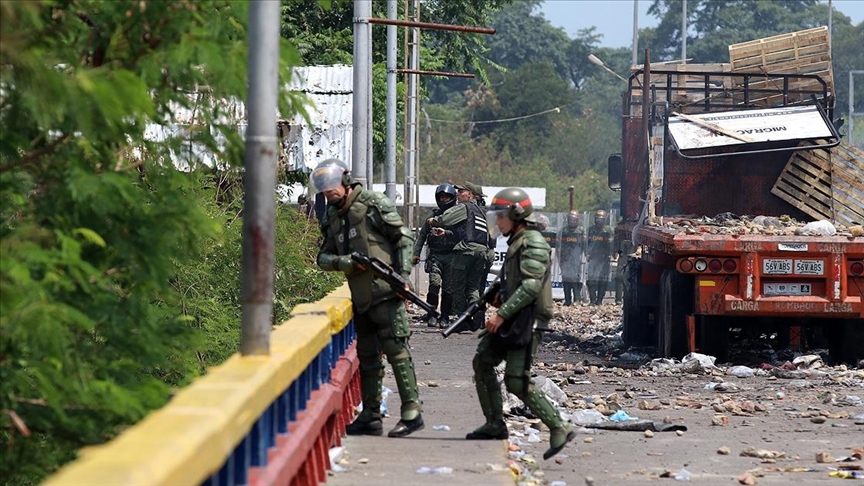
CARACAS
The Trump administration’s threat of military intervention in Venezuela is only the latest chapter in Washington’s long history of coups in Latin America dating back to 1898.
The U.S. gave unlimited support to Venezuela’s opposition on Feb. 23, when the government of socialist President Nicolas Maduro refused to allow the entry of humanitarian aid.
President Donald Trump has repeatedly stated that sending troops to Venezuela is an option while Secretary of State Mike Pompeo said recently he was certain that Maduro's days are numbered.
In slightly less than 100 years, from 1898 to 1994, the U.S. intervened successfully to change governments in Latin America at least 41 times, or once every 28 months for an entire century, according to an article in the Harvard Review of Latin America by American Professor John H. Coatsworth titled ‘United States Interventions’.
U.S. troops and agents have been involved in both direct and indirect interventions, Coatsworth said, and although the main roles were played by local actors, they could not act or succeed without the support of the U.S. government.
The following are the main instances of U.S. involvement in Latin American regime change.
Cuba, Puerto Rico
The U.S. made its first interventions in the region in Puerto Rico and Cuba in 1898. In 1906, the U.S. overthrew Cuba's first elected president, Tomas Estrada Palma.
In 1917, Cuba was once again occupied by the United States, but it gained its independence over time.
In 1898, during the Spanish-American War, Puerto Rico was invaded and subsequently became a dominion of the U.S. and remains a U.S. colony.
Panama
The U.S. began supporting separatist forces to complete the Panama Canal project, which had been left idle by the French. The canal was opened on Aug. 15, 1914.
While the U.S. maintained its influence in Panama with the governments it established, anti-Americanism increased because of the canal, which divides the country into two parts.
Former CIA agent General Manuel Noriega, who headed Panama's national defense forces, became the country’s ruler in 1983, two years after the death of de facto ruler Gen. Omar Torrijos in a plane crash.
Noriega became a target of the U.S. after relations between him and Washington worsened. The U.S. invaded the country to overthrow Noriega on Dec. 20, 1989.
As a result of the occupation, in which more than 25,000 soldiers took part, Noriega surrendered and Guillermo Endara Galimany assumed control.
Nicaragua
Washington's occupation of Nicaragua from 1912 to 1933 took place as part of the Banana Wars, in which the U.S. military intervened in various Latin American countries from 1898 to 1934. America’s goal in this occupation was to prevent the Nicaragua Canal from connecting the Caribbean Sea to the Pacific Ocean.
In 1926, the U.S. was involved in the civil war between the conservative government and liberal forces.
Intervening in the country in 1927, the U.S. defeated the liberals and established its own rule. In 1981, the U.S. backed the Contra forces to overthrow the leftist government. U.S. support continued despite a ban by Congress on aid to the Contras.
It is estimated that at least 30,000 people died as a result of this war.
Mexico
The U.S. sent troops to fight the revolutionaries during the Mexican Revolution, including Pancho Villa and Emiliano Zapata. Washington backed a coup against President Francisco Madero in 1913 to protect its relations with dictator Porfirio Diaz, who had gone into exile after controlling the country for more than 30 years, and brought in General Victoriano Huerta as head of state.
When Woodrow Wilson took charge of the White House, support for Huerta was withdrawn and a weapons embargo was implemented. On April 21, 1914, the port of Veracruz was occupied to prevent Huerta from dispatching weapons.
On Nov. 23, Venustiano Carranza replaced Huerta.
Haiti
The U.S. military occupied Haiti in 1915 to protect its economic interests. It is stated that thousands of people died during the U.S. invasion. In 1934, the U.S. exited the country, leaving a loyal army behind.
The U.S., which once again occupied the country in 1994, intervened to "protect democracy" after the collapse of Jean-Bertrand Aristide’s government.
Guatemala
In 1954, the CIA organized a coup d'état codenamed PBSUCCESS against President Jacobo Arbenz, who came to power through democratic elections.
As a result, the Arbenz government was replaced by a military junta headed by Colonel Carlos Castillo Armas, while the U.S. regained its economic and military interests.
Dominican Republic
Juan Bosch won democratic elections in 1962, following the assassination of U.S.-backed dictator Rafael Leonidas Trujillo, who was held responsible for the deaths of up to 30,000 people.
But Bosch, who was accused by the U.S. administration of not being tough enough against Communism, was overthrown the following year. A rebellion that began in 1965 to return Bosch to power was thwarted by a U.S. occupation of more than 40,000 troops.
In 1966 elections, a pro-U.S. government came to power.
Grenada
Socialist Maurice Bishop seized power in 1979 on the island nation of Grenada in a bloodless coup. The U.S invaded the country in 1983, fearing Grenada would fall under the influence of the Soviets.
As a result, Bishop was killed, and the island came under the influence of the White House
Other interventions
The U.S. also intervened in Bolivia (1944, 1963, 1971), Brazil (1964), Chile (1973), Argentina (1976), Cuba (1934), El Salvador (1961, 1979), Guatemala (1963, 1982, 1983), Guyana (1953), Honduras (1963), Mexico (1913) and Panama (1941, 1949, 1969).
It also has a record of failed intervention efforts in the region.
Writing by Beyza Binnur Donmez
Anadolu Agency website contains only a portion of the news stories offered to subscribers in the AA News Broadcasting System (HAS), and in summarized form. Please contact us for subscription options.








